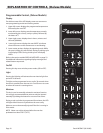
Part # MPSM07 (03/24/08)Page 14
IMPORTANT
ALL GAS BURNERS AND PILOTS NEED SUFFICIENT AIR TO OPERATE AND LARGE
OBJECTS SHOULD NOT BE PLACED IN FRONT OF THIS OVEN, WHICH COULD
OBSTRUCT THE AIRFLOW THROUGH THE FRONT. OBJECTS SHOULD NOT BE PLACED
ON MAIN TOP REAR OF THE OVEN WHILE IN USE. THIS COULD OBSTRUCT THE
VENTING SYSTEM OF THE OVEN’S FLUE PRODUCTS.
VENTILATION AND AIR SUPPLY
Proper ventilation is highly important for eective operation.
There are only two choices for properly venting an oven:
1) canopy hood, or, 2) direct venting. The ideal method of
venting a gas oven is through the use of a properly designed
canopy hood. The hood should extend beyond all sides of the
oven 6 inches, (150 mm), and be installed at least 78 inches,
(1950mm), from the oor.
A strong exhaust fan will create a vacuum in the room. For
exhaust system vents to work properly, exhaust and make-up
air must be balanced. For proper air balance, contact your
local H.V.A.C. contractor.
All gas burners and pilots need sucient air to operate
and large objects should not be placed in the rear or at
the bottom of this oven which would obstruct the airow
through the front covers. Do not place objects over the oven
vent exit.
Some localities require an electric oven to be installed under
an exhaust hood. Be sure to consult your local code inspector
prior to operating any gas or electric oven.
INSTALLATION OF A DIRECT VENT
When the installation of a canopy hood is impossible, the
oven may be direct vented. Before direct venting check you
local codes on ventilation, in the absence of local codes
refer to the National Fuel Code NFPA 54, ANSI Z223.1 (latest
revision).
If the oven is to be connected to a direct ue vent, it is
necessary that a draft diverter be installed to ensure proper
ventilation.
The draft diverter should be positioned on the main top of
the oven and fastened with sheet metal screws provided. All
parts described above are available from the manufacturer.
Note: Each oven has been factory tested and adjusted
prior to shipment. It may be necessary to further adjust the
oven as part of a proper installation. Such adjustments are
the responsibility of the installer. Adjustments cannot be
considered defects in material or workmanship and they are
not covered under the original equipment warranty.
DO NOT UNDERSIZE THE VENT PIPE! This can cause resistance
to ow and impede good venting. We suggest that if a
horizontal run must be used it should rise no less than 1/4”
(6.25mm) for each linear foot of run, and after a total of 180°
of bends you should increase the size of stove pipe by 2”. The
ue should rise 2’ (60 cm) to 3’ (90 cm) above the rooine or 2’
(60cm) to 3’ (90cm) above any portion of a building within a
horizontal distance of 10’ (3 m).
Termination Less than 10 feet (3 meters) from ridge Termination More than 10 feet (3 meters) from ridge
Less than 10 feet (3 meters)
More than 10' (3 meters)
2' (60cm) Min.
3' (90cm) Min.
3' (90cm) Min.
Figure 6.


















